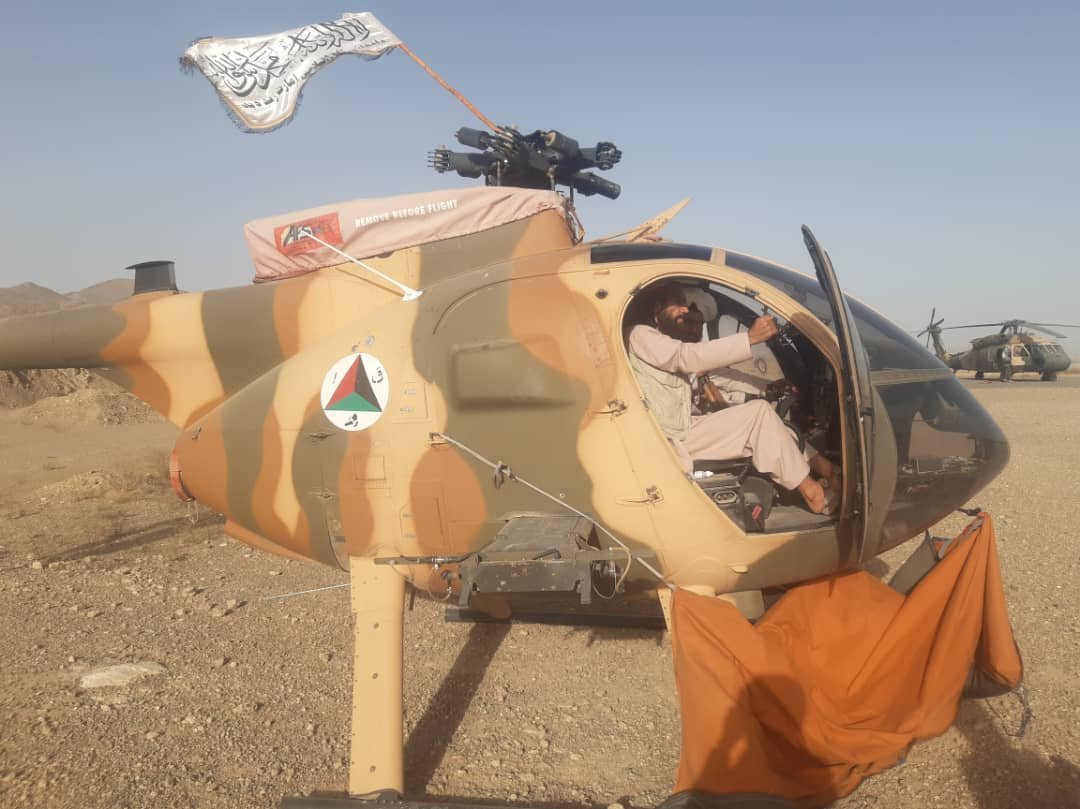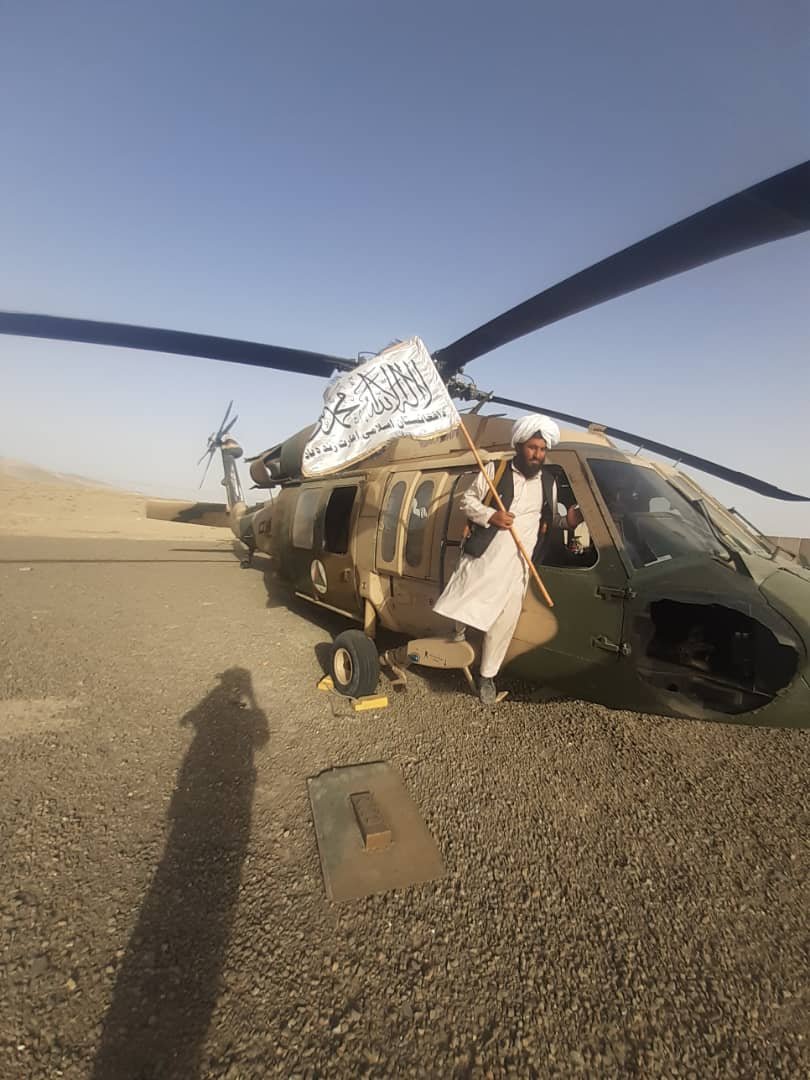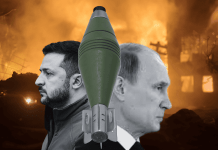Thanks to the US, the Taliban now have an “air force” with advanced choppers and planes with control over eleven military bases, but do they have the technical know-how to operate these aircraft?
- TALIBAN TERROR: China Conducts Counter-Terror Drills With Tajikistan; Afghan Embassy Declares Saleh The ‘New President’
- Taliban’s ‘Top Boss’ Is Indian Military Academy Alumnus; Can New Delhi Leverage Old Contacts To ‘Win Back’ Afghanistan?
Following two decades of “war on terror”, the US-led NATO troops have withdrawn from Afghanistan. And as Kabul fell and the government fled, the marauding Taliban are in control of US military aircraft including Black Hawks, A-29 attack planes, MD-530 utility helicopters besides Russian Mi-24 assault choppers.
There are also reports of the US State Department abandoning a couple of Boeing Vertol CH-46 Sea Knight medium-lift helicopters in Afghanistan.

The 90 days between April and July 2021 saw the US arm the Afghan National Defense and Security forces (ANDSF) with six A-29 light attack aircraft along with a host of ground weapons for its land forces.
However, as the Taliban seized power in Kabul, social media was flooded with pictures of insurgents posing with some of the above-mentioned aircraft.
Pentagon’s ‘Gift’ To Taliban
Last month alone, the Pentagon sent around 40 Black Hawks along with additional Super Tucano aircraft in an effort to aid the Afghan National Army to sustain logistics for military operations ahead of the Taliban takeover.
“Is a Taliban takeover of Afghanistan now inevitable?” was a question posed to US President Joe Biden during a media interaction at the White House on July 8, to which POTUS said, “No it is not.” Biden was asked by White House reporters why he felt that way. He responded, “Because…the Afghan troops have 300,000 well-equipped — as well-equipped as any army in the world — and an air force against something like 75,000 Taliban. It is not inevitable.” The US President was proven wrong a month later.

Conflict watchers and security analysts often cited the Taliban’s lack of air power being their major vulnerability to Afghan security forces in the run-up to their march to the Presidential Palace.
The Taliban is no longer a ragtag group of armed insurgents and is on the verge of establishing itself as a full-fledged government, with enough resources and finances to invest in its battle-hardened fighting force.
Reports indicate that 23 A-29 attack planes, four C-130 cargo planes, and 33 militarized versions of the Cessna Caravan for light attack missions were in use by the Afghan Air Force until last week. It had 150 helicopters including the American UH-60 Black Hawk utility helicopters, armed MD-530s, along with Soviet Mi-17 which were on the verge of retirement.
- Chinese J-20, Russian Su-57 Racing To Develop World’s 1st Stealth Fighter Jet With ‘Super Capabilities’
- Dream Come True For Aviation Enthusiasts As Microsoft Develops Platform To ‘Fly’ World’s Most Powerful Fighter Jet – F-35B
The A-29 Super Tucano is an attack plane designed for counter-insurgency operations. It was perhaps the most sophisticated aerial asset in the Afghan military’s inventory.
Can Taliban Operate These Aircraft?
Bradley Bowman, who served in Afghanistan as a Black Hawk pilot, has been critical about the abrupt American withdrawal and has voiced his concerns to Defense News saying, “There’s no doubt that they’ve captured hundreds of Humvees and artillery and other equipment — and aircraft.
This should be deeply, deeply troubling to Americans, not only because we help fund those and provide those, but because of how the Taliban could benefit.”
He went on to say, “Why the heck wouldn’t we destroy every rotary-wing and fixed aircraft that the Taliban has captured? I think we absolutely should.” Bowman believes the Taliban could recruit pilots who had served in the Afghan air force, perhaps through coercion.

General Mark Kelly, who leads the US Air Combat Command, addressed public concerns over the Taliban gaining access to US air assets. He explained that the technology in the A-29 and other air assets in Taliban possession are not state-of-the-art.
Richard Aboulafia, an aerospace analyst with the Teal Group told Defense News that the Taliban may even attempt to sell the American aircraft in their possession to Moscow or Beijing for reverse-engineering sensitive tech for R&D purposes.
Doing so may not pay them much in the way of dividends because if the “Russians or Chinese wanted to get their hands on a Super Tucano or early model Black Hawk it wouldn’t be that hard. They were equipped in a pretty low-tech way,” he told Defense News.
Gen. Kelly, at the press briefing, had listed several obstacles which the Taliban would face if they attempted to operate the aircraft. The lack of training required to safely fly the aircraft and successfully operate its sensors and load and deploy its onboard munitions was a key point.
“They may actually be able to get it airborne…but they’d probably be more dangerous to their own wellbeing than they would to people on the ground,” he told reporters.
Russia May Step In
Speculation is rife that the uber-rich Taliban leadership may approach Beijing or the Kremlin to maintain and operate their newfound military hardware. It is poignant to note that Moscow, though its controversial Wagner group (PMC), has been doing the same in other global hotspots, whilst maintaining plausible deniability.
Mick Mulroy who served as a former deputy assistant secretary of defense for the Middle East during the Trump administration shared these concerns with Foreign Policy magazine. “What they are going to do is hire Russian contractors now so they can fly their aircraft”.
Video reportingly shows #Taliban captured Kunduz airport with #Afghanistan Air Force Mi-35 Hind attack helicopter pic.twitter.com/u7jZJdR800
— Joseph Dempsey (@JosephHDempsey) August 11, 2021
The shadowy Wagner Group has its presence in multiple conflict zones ranging from Ukraine, Libya, Syria to the Central African Republic, Sudan, and possibly more. The US Treasury had highlighted this in June 2017 by saying that a Russian mercenary group “has recruited and sent soldiers to fight alongside separatists in eastern Ukraine.”
One Dmitry Utkin had been identified by the US as being Wagner’s “founder and leader.” Media reports in Russia have tried to trace the group’s covert origins by quoting anonymous military sources that its founder had served in a special forces brigade of the GRU (Russian military intelligence).
Utkin is reported to have gone to Syria in 2013 along with a group of fighters recruited by a company called Slav Corps. RBC News in Russia had quoted anonymous sources who claimed that the GRU covertly oversees Wagner.
Covert Russian presence in Afghanistan supporting and training the Taliban draws parallels to the US Central Intelligence Agency’s ‘Operation Cyclone’ which funded and armed the Afghan Mujahideen to harass the Russian forces to make their stay and withdrawal difficult, probably as payback for America’s experience during the Vietnam war, which saw the Soviet KGB’s covert influence.
The US aided the Afghans in the ousting of the Soviets, now with the US gone perhaps Russia may pick up the pieces in its great game; this time by using Russian private military contractors to sustain the Taliban’s evolving military machine.
More @ EurAsian Times
- US Experiments With ‘Revolutionary Air Combat Training’ For Fighter Pilots To Dogfight Russian, Chinese Jets
- Despite J-20 Stealth Jet, Why Is China Keen To Acquire Another Stealth Fighter – Russian Su-57 To Its Arsenal?




